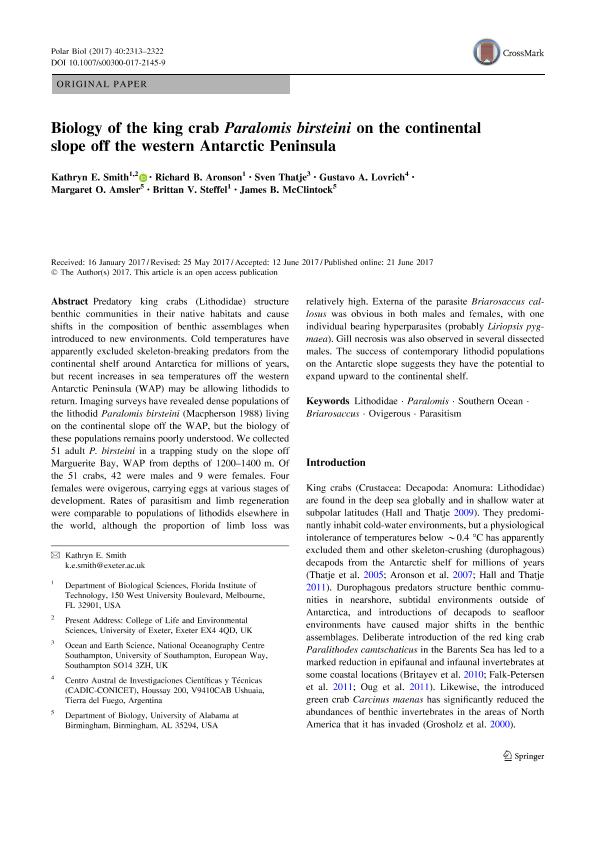Artículo
Biology of the king crab Paralomis birsteini on the continental slope off the western Antarctic Peninsula
Smith, Kathryn E.; Aronson, Richard B.; Thatje, Sven; Lovrich, Gustavo Alejandro ; Amsler, Margaret O.; Steffel, Brittan V.; McClintock, James B.
; Amsler, Margaret O.; Steffel, Brittan V.; McClintock, James B.
 ; Amsler, Margaret O.; Steffel, Brittan V.; McClintock, James B.
; Amsler, Margaret O.; Steffel, Brittan V.; McClintock, James B.
Fecha de publicación:
11/2017
Editorial:
Springer
Revista:
Polar Biology
ISSN:
0722-4060
Idioma:
Inglés
Tipo de recurso:
Artículo publicado
Clasificación temática:
Resumen
Predatory king crabs (Lithodidae) structure benthic communities in their native habitats and cause shifts in the composition of benthic assemblages when introduced to new environments. Cold temperatures have apparently excluded skeleton-breaking predators from the continental shelf around Antarctica for millions of years, but recent increases in sea temperatures off the western Antarctic Peninsula (WAP) may be allowing lithodids to return. Imaging surveys have revealed dense populations of the lithodid Paralomis birsteini (Macpherson 1988) living on the continental slope off the WAP, but the biology of these populations remains poorly understood. We collected 51 adult P. birsteini in a trapping study on the slope off Marguerite Bay, WAP from depths of 1200–1400 m. Of the 51 crabs, 42 were males and 9 were females. Four females were ovigerous, carrying eggs at various stages of development. Rates of parasitism and limb regeneration were comparable to populations of lithodids elsewhere in the world, although the proportion of limb loss was relatively high. Externa of the parasite Briarosaccus callosus was obvious in both males and females, with one individual bearing hyperparasites (probably Liriopsis pygmaea). Gill necrosis was also observed in several dissected males. The success of contemporary lithodid populations on the Antarctic slope suggests they have the potential to expand upward to the continental shelf.
Palabras clave:
BRIAROSACCUS
,
LITHODIDAE
,
OVIGEROUS
,
PARALOMIS
,
PARASITISM
,
SOUTHERN OCEAN
Archivos asociados
Licencia
Identificadores
Colecciones
Articulos(CADIC)
Articulos de CENTRO AUSTRAL DE INVESTIGACIONES CIENTIFICAS
Articulos de CENTRO AUSTRAL DE INVESTIGACIONES CIENTIFICAS
Citación
Smith, Kathryn E.; Aronson, Richard B.; Thatje, Sven; Lovrich, Gustavo Alejandro; Amsler, Margaret O.; et al.; Biology of the king crab Paralomis birsteini on the continental slope off the western Antarctic Peninsula; Springer; Polar Biology; 40; 11; 11-2017; 2313-2322
Compartir
Altmétricas



